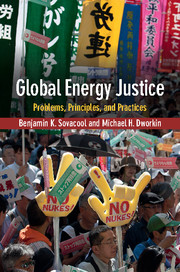Book contents
- Frontmatter
- Epigraph
- Dedication
- Contents
- Analytical table of contents
- List of figures
- List of tables
- Acknowledgements
- List of abbreviations
- 1 Introduction
- 2 The global energy system
- 3 Virtue and energy efficiency
- 4 Utility and energy externalities
- 5 Energy and human rights
- 6 Energy and due process
- 7 Energy poverty, access, and welfare
- 8 Energy subsidies and freedom
- 9 Energy resources and future generations
- 10 Fairness, responsibility, and climate change
- 11 The imperative of making just energy decisions
- Index
- References
5 - Energy and human rights
Published online by Cambridge University Press: 05 October 2014
- Frontmatter
- Epigraph
- Dedication
- Contents
- Analytical table of contents
- List of figures
- List of tables
- Acknowledgements
- List of abbreviations
- 1 Introduction
- 2 The global energy system
- 3 Virtue and energy efficiency
- 4 Utility and energy externalities
- 5 Energy and human rights
- 6 Energy and due process
- 7 Energy poverty, access, and welfare
- 8 Energy subsidies and freedom
- 9 Energy resources and future generations
- 10 Fairness, responsibility, and climate change
- 11 The imperative of making just energy decisions
- Index
- References
Summary
The externalities and premature deaths associated with energy production and use elaborated on in Chapter 4 raise another interesting ethical dilemma: how are we to value human life when we weigh costs and benefits? Imagine that it is a quiet autumn afternoon in Washington, DC, and you are sitting in your office at the US EPA, preparing your memorandum to the Assistant Administrator for the Office of Air and Radiation. She has asked you to recommend a permissible level for toxic emissions coming from large electricity generating plants. You know that stricter standards will cost significantly more in terms of air pollution equipment (and result, ultimately, in higher energy prices), but you also know that tougher standards will save many lives from death or ruin by reducing the health effects of mercury and other heavy metals emissions.
Thus, there is an obvious tradeoff between protection of human health and costs of emissions control. How can you turn this from an abstract, “gut reaction,” personal-values comparison to a quantifiable one of “deaths and dollars” that you can present for recommendations and debate? On the one hand, the electric utility industry asserts that stricter standards could result in the closure of sixty-eight coal-fired power plants – 8 percent of the country’s entire fleet – risking blackouts and massive job layoffs. The industry will also have to spend $11 billion by 2016 installing better scrubbers and pollution abatement equipment at their power plants, costs that will be passed onto households. On the other hand, EPA analyses and National Academies of Science studies suggest that stricter pollution controls will yield annual monetized benefits of $59 to $140 billion through 17,000 fewer annual deaths caused by PM and mercury pollution. As the EPA’s own report concludes, “the benefits outweigh costs by between 3 to 1 or 9 to 1 depending on the benefit estimate and discount rate used.”
- Type
- Chapter
- Information
- Global Energy JusticeProblems, Principles, and Practices, pp. 157 - 190Publisher: Cambridge University PressPrint publication year: 2014



